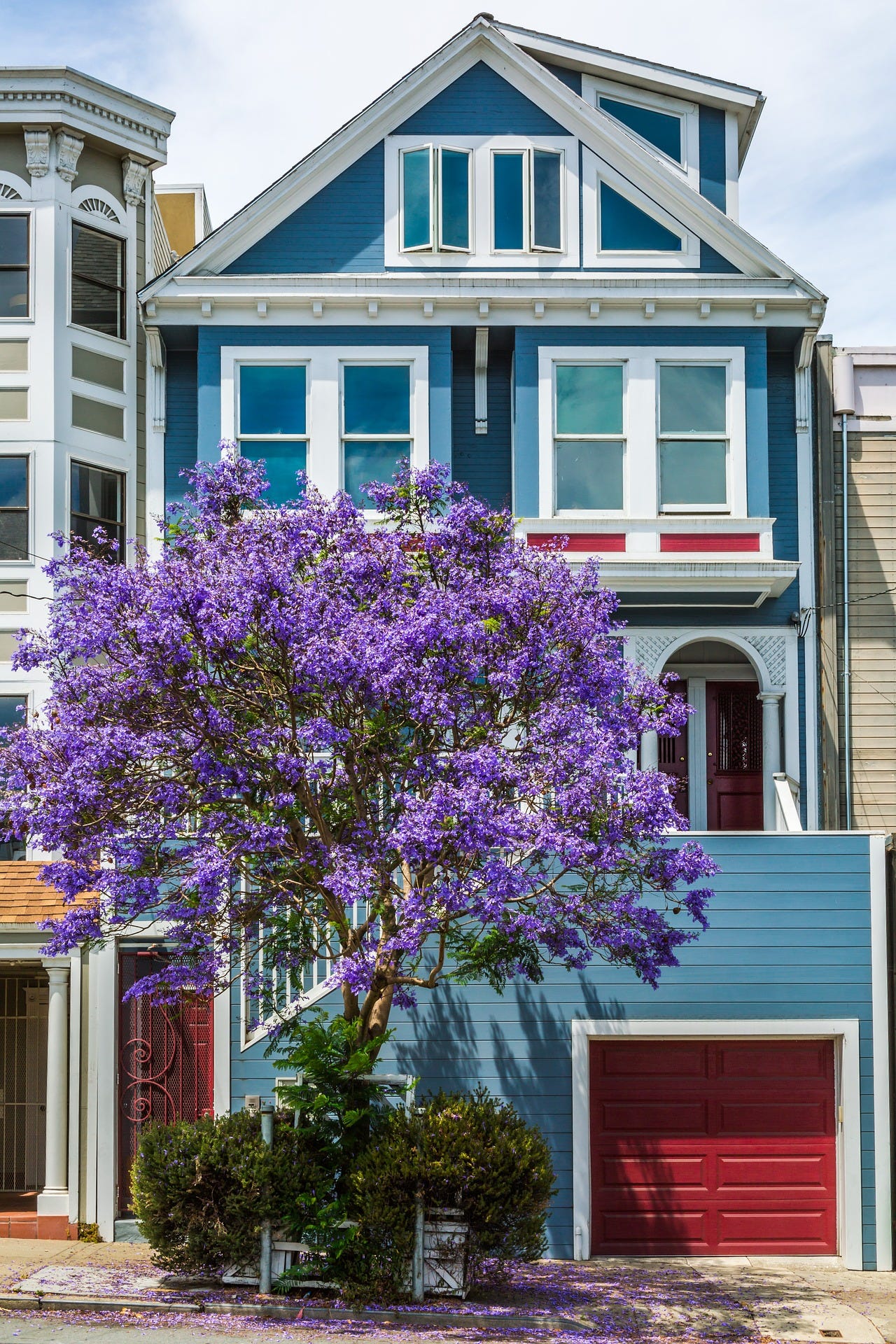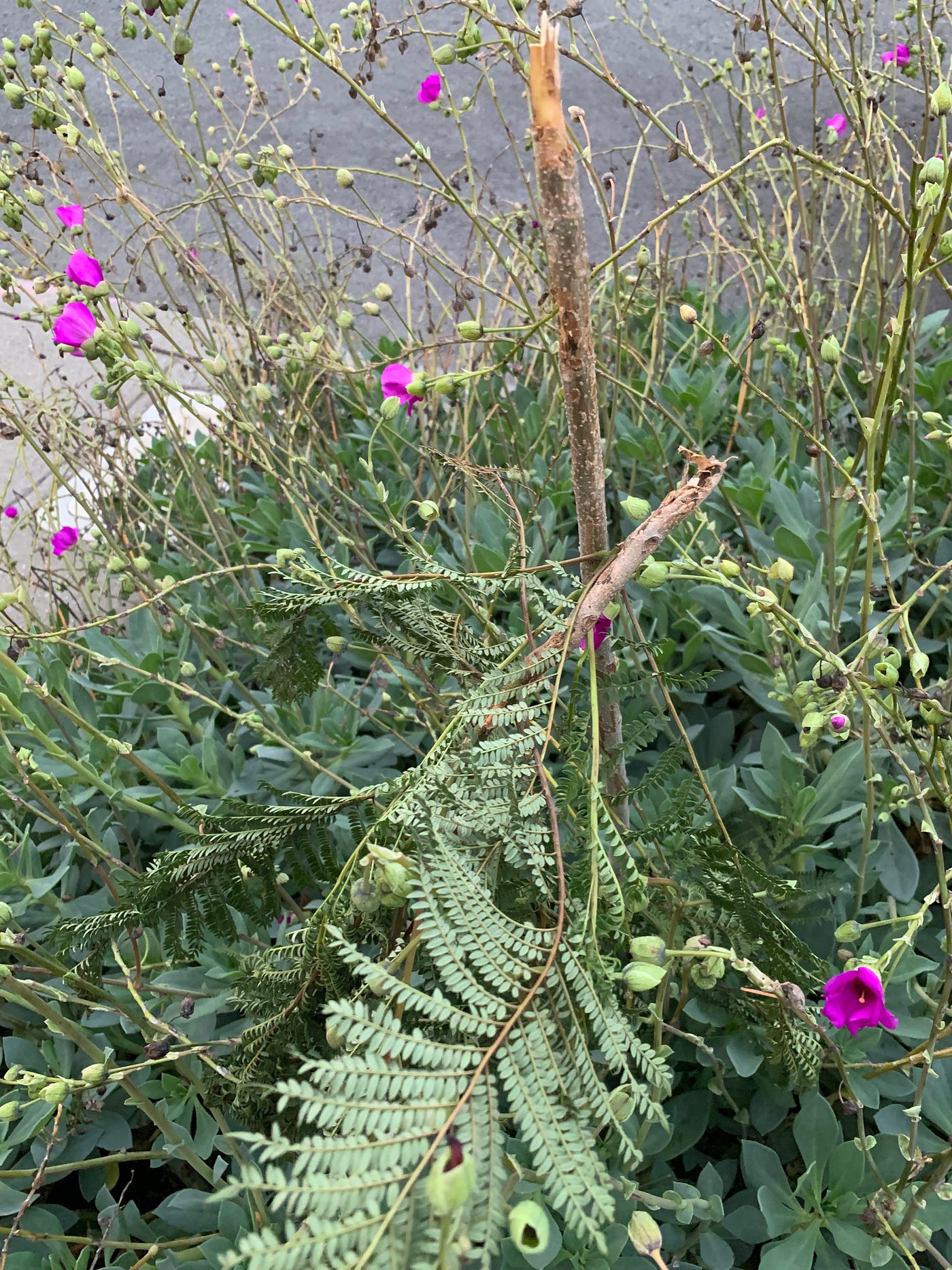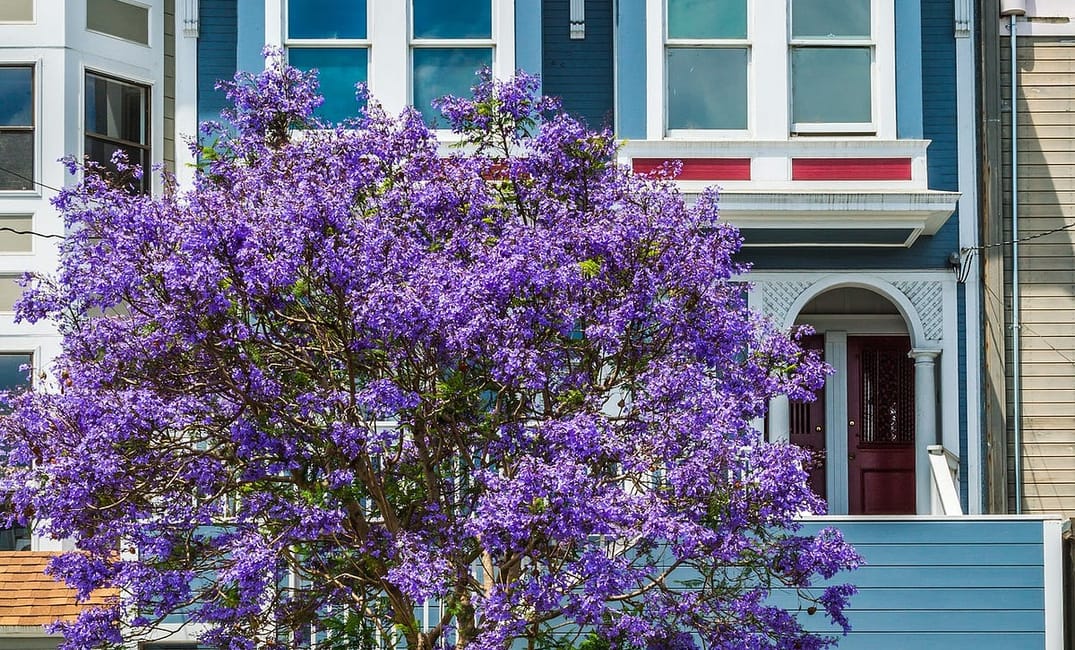
We chose to live on our tree-lined street because the plants helped create an aura of neighborliness, a sense of community, and a buffer from the harshness and grit of city life. But the cumulative attacks on our trees feel brutal, and nihilistic, degrading the place we’ve called home for more than twenty years. If Pearl Buck was right that “the test of a civilization is the way that it cares for its helpless members,” then the city is failing. I can’t even protect our defenseless trees.
Sign up for The Bold Italic newsletter to get the best of the Bay Area in your inbox every week.
We’re moving away from San Francisco for a variety of personal reasons, but the ongoing assault on our urban forest helps affirm our decision to leave.
I planted my jacaranda a year ago. I dug rock-hard, tawny clay out of the square in the sidewalk, and filled the basin with topsoil. I uncoiled the rootball and eased the slender, barren stick into the ground. I pounded in two sturdy stakes, six feet tall, for guidance and protection. I watered my tiny tree through a year of record drought. Leaf buds bulged, then morphed into tiny leaves. I envisioned, years from now, my jacaranda, posed in front of my salmon pink house, cloaked in luxuriant purple petals, exuberantly sharing its color and fragrance with my neighbors.
Within the first few months, someone sliced the twine lacing the tree to the support stakes. I retied and then replaced the string; I did this twice. After the first lacy leaves unfurled, someone snapped off one of the stakes a few inches above the ground. They left the lumber sprawled on the sidewalk. I pounded the foreshortened stake back into the ground. Weeks later, someone pulled it out. Months passed. The second stake was yanked out of the ground and carted off. Maybe it was time for me to pull up the stakes and move on.
But my little tree persisted. I fed it water and sips of tea from my worm bin. By late summer more than twenty feathery, footlong leaves crowned its trunk. The four clumps of succulents I had planted in the barren square had grown together, flowing onto the sidewalk. The plump leaves and hot pink flowers of the rock purslane (calandrinia) provided a verdant, protective blanket around the jacaranda. It looked like my little tree had survived. It would make it.
The jacaranda replaced a Washington hawthorn that was already past its prime when we moved in. For years, the hawthorn’s orange berry clusters continued to feed flocks of robins and cedar waxwings, and clog the sidewalk with debris, but the tree was clearly declining. At one point the hawthorn had graced the cover of Trees of San Francisco. In its last few seasons, leaves would fail to emerge from one of the main branches, twigs would wither, and in the fall I would saw off that dead limb. A single, flourishing, twisting branch persisted for two years, until someone swung from it, cracking the trunk lengthwise.
I spent two long days with a pickaxe, shovel, and pruning saw trying to dig out the tough, dense wood embedded in golden clay concrete. The sidewalk and massive, convoluted roots restricted the swing of my pickaxe. Eventually, we paid professional gardeners to remove the stump. After my efforts, they spent an additional hour with a chain saw and shovels, lopping off roots and loosening soil, and still had to tie the trunk to the bumper of their truck and rev the motor several times, before they could pull it out.
I gained more respect for the hawthorn. Its roots had riven that harsh earth for decades in order for the visible tree to flourish. But the jacaranda was a better match for the Pacific coast and a warming world.

In late October, someone snapped off my jacaranda. They reached into the midst of the two-foot-tall mound of succulents, bending and twisting the top off my tree. They left the severed head next to the trunk.
The stake-breaking could have been the midnight action of drunken revelers leaving one of the nearby bars. Other nights have left our sidewalk plot littered with beer cans, napkins, half-eaten sandwiches, batteries, lipstick tubes, dog excrement, and human feces. Acts of sloppiness and inconsideration. But decapitating the jacaranda was an act of deliberate, intentional destruction.
Several of the patients that come to my in-home psychiatric office identified with the tree. They voiced anxious anticipation during the long winter months of dormancy. They earnestly counted the number of buds, and how much the tiny leaves grew between visits. They marveled at how the tree was finding the right place to put its roots down, was learning how to contend with the weather, the soil, the flow of human traffic. It served as a model for adapting to a harsh city environment and sharing the space with others. They were rooting for the jacaranda’s success.
To me, vandalism has always seemed a particularly cowardly way to vent one’s anger and frustration. Yet I can understand the thrill of violent mayhem in breaking a window, keying a car door, or knocking over a garbage can. Sometimes graffiti even enhances prefab construction or derelict urban architecture. But I get really angry when I see plants that have been brutalized. I’m not generally a violent person, but I fear that were I to actually witness someone maiming a tree, I’d have an impulse to slam the culprit’s head into the sidewalk to replicate the destruction they wrought.
Why would you hurt a living thing? Why destroy beauty? Why desecrate something shared by a community? How could you injure a symbol of resilience and inspiration? Plants lead innocent lives.They’re sessile. While not devoid of defenses, their tough bark or sharp thorns don’t help them run or hide to avoid a human assailant. Talk about sitting ducks — they can’t even duck.
Fantasy authors capitalize on the immobility and passivity of trees to conjure up strikingly discrepant characters. The apple trees in the Wizard of Oz slap back at Dorothy. Tolkien's Ents marching out of Fangorn Forest to confront the Lord of the Rings. The Whomping Willow of Hogwarts guarding the entrance of the hidden tunnel to Hogsmeade. Groot provides brute strength as a Guardian of the Galaxy. But in real life trees don’t usually fight back.
Although occasionally, some trees do fight back.
In my thirty years in the city, a handful of people have been maimed or killed by falling limbs or trees in city parks. The San Francisco Department of Public Works usually deems these tree-murderers worthy of capital punishment, peremptorily chopping them down. About the only other capital offense a tree can commit in San Francisco is blocking someone’s view. This is also merits execution.
I was actually attacked by a tree on my first visit to San Francisco, two years before I moved there. As a midwesterner, I was used to wide suburban street lawns, lined with house-sized trees: oaks, elms, maples, or even locusts, whose lowest limbs were several feet above the head of the average human. Who would plant trees in the middle of busy sidewalks? With branches right at face level? I crossed a street near the Marina Green, and almost had my ears boxed by a Victorian Boxtree. I could have headed off the collision by looking for forehead-level obstructions, but let’s face it, I didn’t. It’s not a mistake I made twice.
But usually, trees play defense against human aggressors. A decade ago someone sawed through dozens of young trees that had been planted in Golden Gate Park. Even though his style was radically different, some suspected the Machete Man, a homeless inhabitant of the Mission and Castro who slashed and hacked away at sidewalk trees for years. The city shouted support for its urban forest, with some lamenting that San Francisco had less tree coverage than any other major US city.
The Machete Man visited our block a couple of times in our first years of living here, leaving detached giant palm fronds, slashed trunks, and lopped limbs in his wake. He didn’t damage our greenery, but he did have competitors in trashing our greenery. I planted kumquat trees three different times in the concrete planters next to the sidewalk. Each was yanked out of the ground within months. I finally chained a replacement calamondin tree to bolts screwed into the concrete. The calamondin grew for years, although the fruit was barely palatable.
Next, I put in tibouchina. The twin Princess Flowers on either side of the driveway grew branches seven feet tall, and for years showered the sidewalk with dark purple petals. But in the last two years, miscreants broke off the branches one by one. The trimmed back trunks continue to bloom, but their stubby, stunted appearances scream both “Survivor!” and “Victim!” at me each time I enter or leave our house. The escalating attacks on the tibouchina, hawthorne, and jacaranda have made me feel under siege in my own yard.
After the top was twisted off the jacaranda, I made a clean cut in the trunk. Record rains fell throughout the fall. Several dozen new leaves sprouted from the trunk. Biologically, the tree has what it takes to survive. But sociologically I think it is doomed. If it escapes the sidewalk violence from an angry, unhinged person, it will probably be yanked out of the soil by the real estate agent who is selling our house. Too tiny, too idiosyncratic, not appealing to the lowest common denominator, not in accord with the gray paint they want to slap on the outside of the house.
I have two healthy, happy, thriving human children. But the plants that I doted on, that I watered, fertilized, and trimmed, felt like my children too. And those in a semi-public setting, at the front of my house, and in the five foot by five foot square in the pavement, were my gifts to the world. I enjoyed offering something alive, and friendly, green, and flowering, and resilient to friends and strangers.
But increasingly, it feels like my offspring are spurned, my gifts are not wanted. San Francisco no longer holds me or welcomes me. Maybe I’ve been barking up the wrong tree. Maybe it’s time to branch out. Or maybe it’s just time to leave the city. The seed for my departure was planted long ago, but the trashing of my little jacaranda was the last straw.







